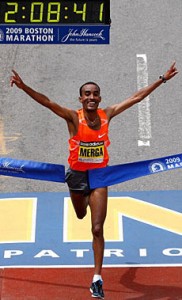One more post on weight loss (or gain), mitochondria density, and metabolic health and then I’ll get back to posting some healthy, gluten-free recipes. I promise. But before I do that, I have to fill in the blanks from my prior post on this subject. To catch up, please see part one—the mitochondria: your own starship enterprise. This two-part series features highlights from last June’s Fitness & Health Bloggers Conference held at the newly opened Anschutz Health & Wellness Center.
Okay, are you ready for a different take on weight loss? Curious, even?
Dr. Iñigo San Millán is the director of the Human Performance Lab at the Anschutz Center. He’s an exercise physiologist and his conference presentation brought together two different areas of customized approaches to fitness. On one end, we have the average person trying to lose weight and get healthy. On the other end, we have world-class, elite, endurance athletes. You know—the kind of people who run ultra-marathons, break world records, win Olympic medals, ride in the Tour de France. Yes, I know, there’s a big gap between average and elite. But according to Dr. San Millán, we have a lot to learn from elite athletes and can apply the same general principles of metabolic health to our own pursuit of fitness.
What is metabolic health, you ask? Overall, it means being healthy and fit in all aspects and on a whole body level (on a cardiovascular, hormonal, emotional, nutritional, and cellular level). Sounds rather yogic, doesn’t it? Mind, body, and spirit health.
Dr. San Millán tossed out some brutal facts about the rising rates of obesity, diabetes, cancer, and cardiovascular disease in the United States. Sixty-eight to seventy percent of the US population is overweight or obese. Two-thirds of Americans are on some sort of diet or weight-loss program at any given time, but 98% of weight loss is gained back. That roller-coaster ride of weight gain, weight loss, weight gain undermines metabolic health and makes it increasingly harder to lose the weight. What’s the answer?
It’s complicated and there’s no magic formula, but there’s a positive side to this. We can make health-enhancing changes at anytime of life. It’s never too late to eat better and move more. BUT, it has to become a way of life, not a temporary “diet” or periodic exercise program.
According to Dr. San Millán, elite endurance athletes are the most fit people on the planet and the only population totally free of acquired metabolic and cardiovascular disease. As Dr. San Millán said in his talk, “Simply, it doesn’t exist.”
So, what makes these elite athletes metabolic super-stars?
High mitochondrial density and metabolic flexibility.
Huh?
In a nutshell: cellular energy requirements control how many mitochondria we have (in “healthy” individuals without a genetic mitochondrial disorder). The more we move (walk, run, hike, bike, ski, play tennis), the more mitochondria we have. Endurance athletes have twice the mitochondrial content as sedentary individuals (Davis et al., 1981, 1982). The more mitochondria we have, the more efficiently we process carbs and fat. The more efficiently we process carbs and fat, the less likely we are to be overweight. If we maintain a healthy weight, there is less risk of insulin resistance, diabetes, and heart disease.
See those legs in the above cycling photo? That’s turbo-charged mitochondrial density in action. It’s unlikely any of those cyclists are overweight or have type 2 diabetes or heart disease. Tour de France riders consume an average of 6000–9000 calories per day. Of those, 75–80% are carbs. Michael Phelps told ESPN that he consumes 8000–10000 calories per day during training and competition. Again, a high percentage are carbs.
Okay, sounds good, but where do we start? And comparing ourselves to elite athletes is a little intimidating, wouldn’t you agree? I don’t know about you, but I’m not going to be running marathons anytime soon. Plus, we’re all different. Each body is unique. We have different adaptations to exercise and different responses to what we eat. But, the good news is, it doesn’t matter how old we are or what shape we’re in, we can make positive changes. We can lose weight. We can eat better. We can become healthier. We can increase our mitochondria and enhance our ability to process carbs and fat. We can thrive.
Here’s the deal. According to Dr. San Millán, physical activity should be the foundation, boosted by a healthy diet. And that healthy diet can include carbs. Healthy carbs aren’t evil, we just need to move our bodies daily to be efficient at processing those carbs.
I agree. We need to make time for activity, at least an hour a day, more if possible. You don’t have to go to the gym or buy expensive equipment. Dance, do yoga, garden, walk your dog, sell your car, move to Paris, become Amish. It’s about permanent lifestyle changes; it’s not about dieting. We need to move more to lose weight, maintain metabolic health, and avoid type 2 diabetes and heart disease.
We don’t have to be an elite athlete, but we can learn from them.
Peace, love, and physical activity! Lots of it. Weight loss will be the side effect!
Melissa


















